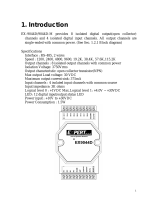
Programmable Device Server User Manual (V1.5, Nov. 2010) 5
8.1 $AA5 -------------------------------------------------------------------------------------------------------------------- 116
8.2 $AA6 -------------------------------------------------------------------------------------------------------------------- 117
8.3 $AAC-------------------------------------------------------------------------------------------------------------------- 118
8.4 $AACN------------------------------------------------------------------------------------------------------------------ 119
8.5 $AAGCN --------------------------------------------------------------------------------------------------------------- 120
8.6 $AALS ------------------------------------------------------------------------------------------------------------------ 121
8.7 $AAF-------------------------------------------------------------------------------------------------------------------- 122
8.8 $AAM------------------------------------------------------------------------------------------------------------------- 123
8.9 @AA -------------------------------------------------------------------------------------------------------------------- 124
8.10 @AA(DATA) ----------------------------------------------------------------------------------------------------------- 125
8.11 #AAN-------------------------------------------------------------------------------------------------------------------- 126
8.12 #AA00DD --------------------------------------------------------------------------------------------------------------- 127
8.13 #AA1NDD --------------------------------------------------------------------------------------------------------------- 128
8.14 ~**----------------------------------------------------------------------------------------------------------------------- 129
8.15 ~AA0-------------------------------------------------------------------------------------------------------------------- 130
8.16 ~AA1-------------------------------------------------------------------------------------------------------------------- 131
8.17 ~AA2-------------------------------------------------------------------------------------------------------------------- 132
8.18 ~AA3EFF---------------------------------------------------------------------------------------------------------------- 133
8.19 ~AA4P ------------------------------------------------------------------------------------------------------------------ 135
8.20 ~AA4S ------------------------------------------------------------------------------------------------------------------ 136
8.21 ~AA5P ------------------------------------------------------------------------------------------------------------------ 137
8.22 ~AA5S ------------------------------------------------------------------------------------------------------------------ 138
8.23 APPLICATION NOTES--------------------------------------------------------------------------------------------------- 139
9. CONSOLE / TELNET COMMANDS LIST-------------------------------------------------------------------------- 141
9.1 OPERATION FLOWCHART--------------------------------------------------------------------------------------------- 141
9.2 REGULATE INIT/NORMAL MODE ------------------------------------------------------------------------------------- 142
9.3 COMPARISON SHEET (INIT/RUN/CONSOLE MODES)---------------------------------------------------------------- 144
9.4 COMMAND LIST -------------------------------------------------------------------------------------------------------- 145
9.4.1 IPFILTER---------------------------------------------------------------------------------------------------------- 146
9.4.2 IPCONF------------------------------------------------------------------------------------------------------------ 147
9.4.3 SOCKET ----------------------------------------------------------------------------------------------------------- 148
9.4.4 COM---------------------------------------------------------------------------------------------------------------- 149
9.4.5 Broadcast---------------------------------------------------------------------------------------------------------- 150
9.4.6 SystemTimeout (ms) ---------------------------------------------------------------------------------------------- 150
9.4.7 SocketTimeout (ms)----------------------------------------------------------------------------------------------- 151
9.4.8 M-------------------------------------------------------------------------------------------------------------------- 151
9.4.9 EchoCmdNo ------------------------------------------------------------------------------------------------------- 152
9.4.10 EndChar-------------------------------------------------------------------------------------------------------- 153
9.4.11 IP---------------------------------------------------------------------------------------------------------------- 154


























